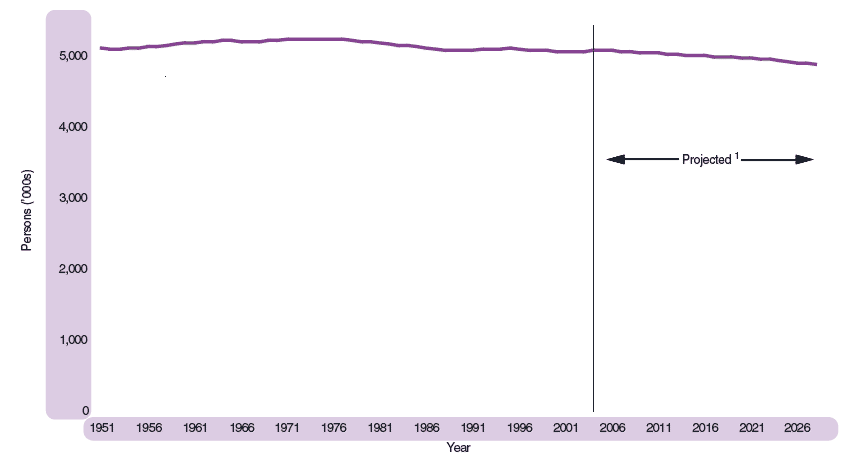
The latest estimate of Scotland’s population (30 June 2004) is 5,078,400 - a rise of 21,000 on the previous year and an increase of 23,600 since 30 June 2002. Eighteen per cent of the population was aged under 16 and 19 per cent was of pensionable age (60 and over for women and 65 and over for men), with the remaining 63 per cent of working age (16-59 for women, 16-64 for men).
In the twelve months to 30 June 2004, there were just over 57,500 deaths which, as in recent years, exceeded the number of births (by about 4,000 in 2003-04). Over the year, in-migrants exceeded out-migrants by around 26,000, reflecting a net gain of around 15,500 from the rest of the UK, a net gain of around 11,700 from overseas (including asylum seekers) and an adjustment of -1,500 for unmeasured migration. Other changes, including adjustments for the prison population and the armed forces amounted to a net loss of around 1,000 people.
The rise in Scotland’s population in the last two years should be seen in the context of the relative stability of the population over the last 50 years, illustrated by Figure 1.1. The population reached a peak of 5.24 million in 1974 and since then has been gradually declining, with some fluctuations. It is still too early to tell whether recent increases in births and people migrating to Scotland is another fluctuation or a change in the long-term trend.
Figure 1.1 Estimated population of Scotland, actual and projected, 1951-2028

1 2003-based projections. 2004-based projections will be published on 20 October 2005.
It can be seen from the trends in Figure 1.2 that the population growth up to 1974 was the result of natural increase being greater than net out-migration from Scotland. But, since 1974, natural increase has fallen dramatically as a result of sharp decline in the number of births (over 100,000 in the 1960s to less than 60,000 since 1996), while the number of deaths has remained fairly constant. This fall in natural change was accompanied by a reduction in net out-migration from Scotland, but net out-migration remained higher than the natural increase during the late 1970s and 1980s, causing the population to decline.
Figure 1.2 Natural change and net migration, 1951-2004
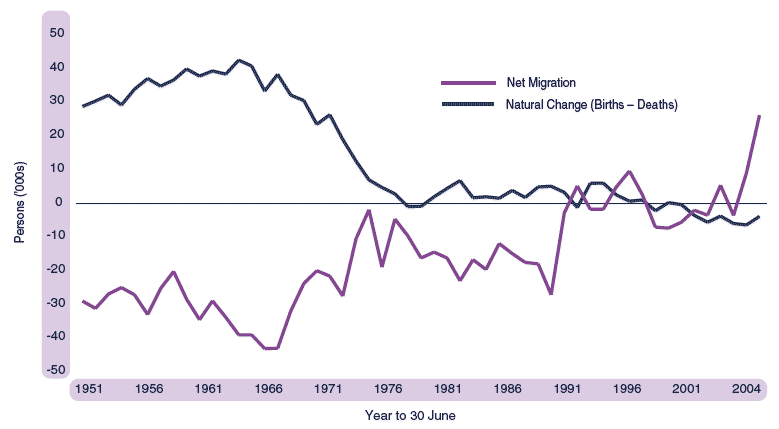
Age structure
The age/sex composition is one of the most important aspects of the population, as changes in different age groups will have different social and economic impacts. For example, increases in the elderly population are likely to place a greater demand on health and social services and decreases in the number of children will mean that fewer school places are needed.
Figure 1.3 Estimated population by age and sex, 30 June 2004
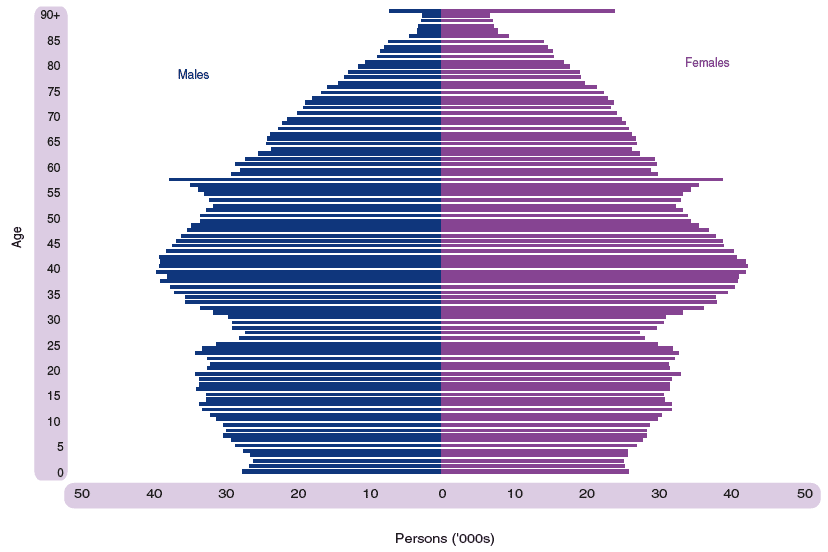
Figure 1.3 shows the age structure of the population in 2004. Using past trends in fertility and mortality as a guide, it is possible to explain the peaks and troughs at different ages. Peaks at ages 55 and around 40 reflect the ‘baby booms’ after the Second World War and in the 1960s. Declining births in more recent years are evident by the tapering of the population under the age of 10. The more stable numbers of 10-20 year olds reflect a levelling off of the decline in births during the 1980s when more women were passing through their childbearing ages.
Amongst older people, particularly over 75, the higher number of females reflects the longer expectation of life for women, partly as a result of higher rates of male mortality during the Second World War. The effects of the `flu epidemic in 1919 and lower levels of fertility during the First World War are also evident from the sharp decline in population aged over 84.
Over the last ten years, Scotland’s population has decreased by around 24,000 (-0.5 per cent) from 5.10 million to 5.08 million. The changing structure of the population since 1994 is illustrated in Figure 1.4. Of particular note is the decrease of 9 per cent in the number of children under 16 and the increase of 16 per cent in the number aged 75 and over. The ageing of the population is evident in the large rise of the 45-59 age group (+13 per cent) and the fall in the 16-29 age group (-14 per cent)
Figure 1.4 The changing age structure of Scotland’s population, 1994-2004
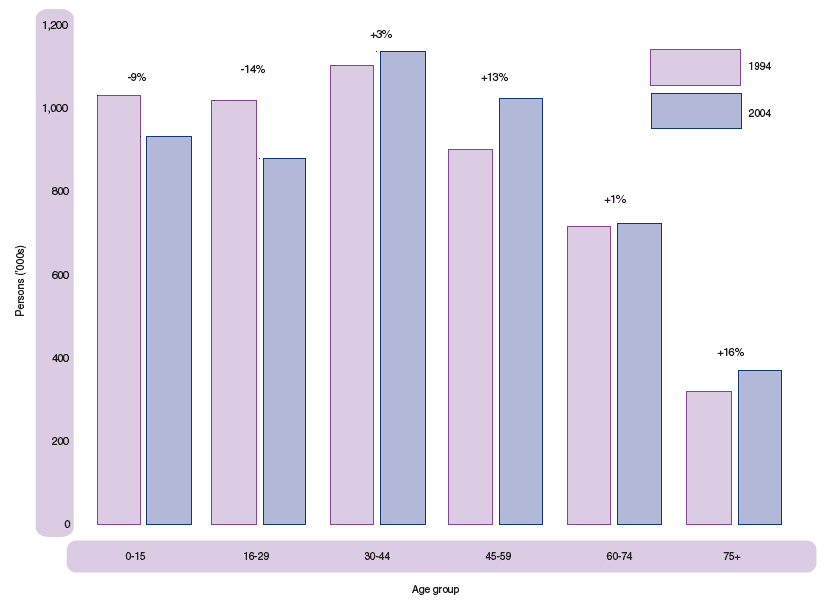
Changes within Scotland
The map at Figure 1.5 shows the percentage change in population between 1994 and 2004 for each Council area. It is better to compare over a time frame longer than one year, as population change can fluctuate from year to year, particularly for smaller areas. In general, the larger urban areas (apart from Edinburgh) are declining, while there are increases in areas around the bigger cities and many rural areas (apart from islands areas). Generally, urban areas have lower levels of fertility, higher mortality and more out-migration. The areas with a growing population tend to experience both net in-migration and an excess of births over deaths, partly because most migrants are of childbearing age.
Figure 1.5 Percentage population change by Council area, 1994-2004
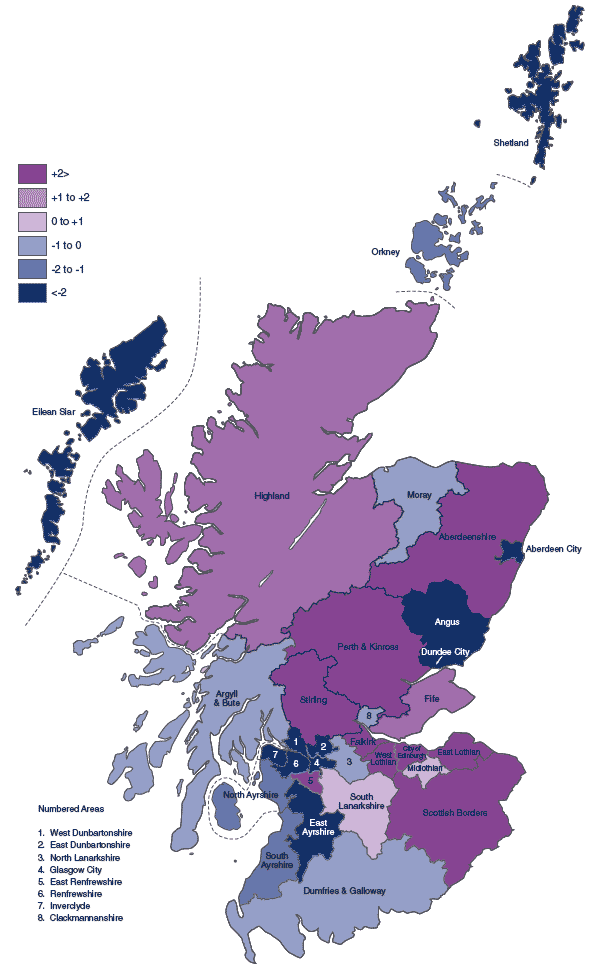
The Council areas which showed the largest decreases over this period were Eilean Siar (-9.8 per cent), Inverclyde (-7.7 per cent) and Aberdeen City (-7.3 per cent). The largest reduction in numbers was for Glasgow City (34,590). The largest increases in population occurred in West Lothian (+10.6 per cent), East Lothian (+6.6 per cent) and Stirling (+5.4 per cent).
Projected population
The slow decline in population is projected – on the basis of existing trends, making no allowance for the impact of government policies and other factors – to continue, resulting in the population of Scotland falling below 5 million in 2017 and reaching 4.88 million in 2028. This projection is based on the 2003 population estimate and a revised projection, based on the higher 2004 estimate, which will be published in October.
Figure 1.6 shows a widening gap between births and deaths, with a natural decrease of almost 14,000 a year by 2028. This is likely to be the main reason for population decline in the future.
Figure 1.6 Births and deaths, actual and projected, Scotland, 1951-2028
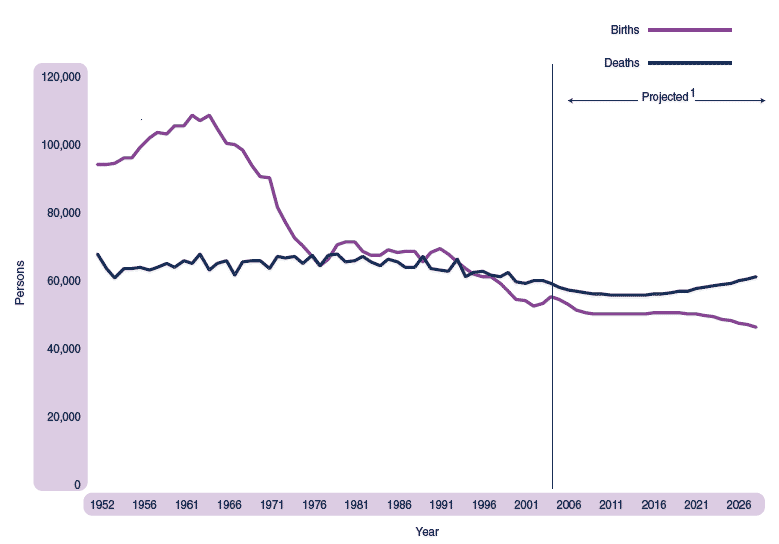
1 2003-based projections. 2004-based projections will be published on 20 October 2005.
Within this decline, significant changes to the age structure are projected (Figure 1.7). The number of children under 16 is projected to fall by 18 per cent by 2028, while there is projected to be an increase of over 60 per cent in people aged 75 and over.
Figure 1.7 The projected percentage change in age structure of Scotland’s population, 2003-20281
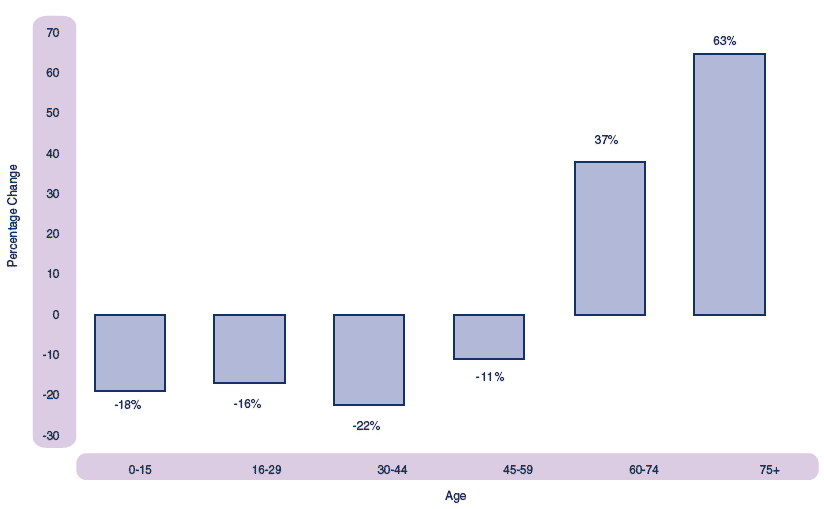
1 2003-based projections. 2004-based projections will be published on 20 October 2005.
As well as preparing these "principal projections", the Government Actuary’s Department (GAD) produce variant population projections, based on alternative assumptions of future fertility, mortality and migration, because demographic behaviour is uncertain. Their purpose is to illustrate plausible alternative scenarios and not to represent upper or lower limits for future demographic behaviour. These variant projections and the underlying assumptions can be found on the GAD website: http://www.gad.gov.uk.
Dependency Ratios
Dependency ratios show the relationship between the working age population and the two main dependent groups – children aged under 16 and people of pensionable age. Figure 1.8 shows this in the long term, with little change evident over the next 15 years, but with a relatively rapid increase in the pension-age population in relation to the working-age population in subsequent years. Over the period up to 2020, rises in the pension age population are largely offset by a reduction in the number of children. Figure 1.8 also reflects the changes being made between 2010 and 2020 to change women’s state pension age to 65.
Figure 1.8 Dependency Ratios (per thousand working population)
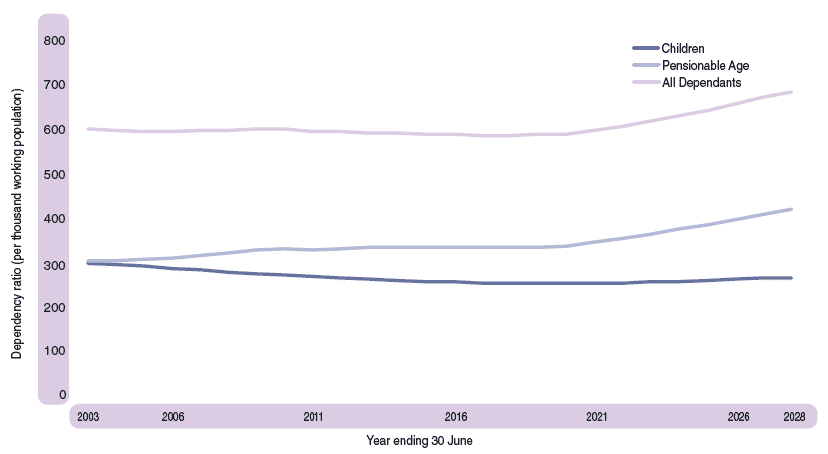
European Comparisons
Scotland is not alone in having a natural decrease in population (i.e. deaths exceeding births). But, for most of Europe, this is compensated by higher in-migration than in Scotland. The population of Europe (EU-25) is projected to increase (by 2.9 per cent between 2004 and 2028). Only the new accession states in eastern Europe have a projected population decline which exceeds Scotland’s, as Figure 1.9 shows:
Figure 1.9 Projected Percentage Population Change in Selected European Countries, 2004-2028
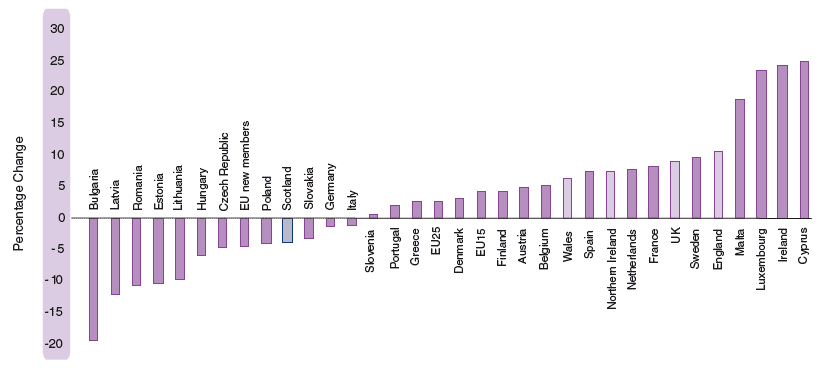
Source: GAD (UK and constituent countries) and Eurostat. Note: Eurostat also publish an alternative UK projection not shown here.
Nor is the ageing of the population unique to Scotland. The pattern of change over the last twenty years is consistent with other countries in the UK and Europe, although the rate of change varies.
The Economic and Social Research Council (ESRC) recently announced a new two-year research initiative into aspects of Scotland’s demographic trends. Funded in partnership with the Scottish Executive, this £300,000 research programme will investigate migration, as well as fertility and the impact of an ageing population. More information about the projects can be found on the ESRC website: http://www.esrc.ac.uk/ESRCInfoCentre/index.aspx
Numbers
The number of births registered in Scotland in 2004 was 53,957. This was 1,525 (2.9 per cent) more than in 2003 and 2,687 (5.2 per cent) more than in 2002. However, the 2002 level was the lowest total since civil registration began in 1855, with only half the births recorded during the ‘baby boom’ of the early 1960s (Figure 1.10). It is unclear whether this recent increase marks a turning point in Scotland’s declining birth rate.
The proportion of births to unmarried parents (including births registered solely in the mother’s name) has continued to rise, reaching 47 per cent in 2004 compared to 31 per cent ten years ago. However, the proportion of births registered solely in the mother’s name has remained relatively constant over this period at 6 to 7 per cent, suggesting that the increase has been in babies born to stable partners.
Figure 1.10 Births and deaths, Scotland, 1951-2004
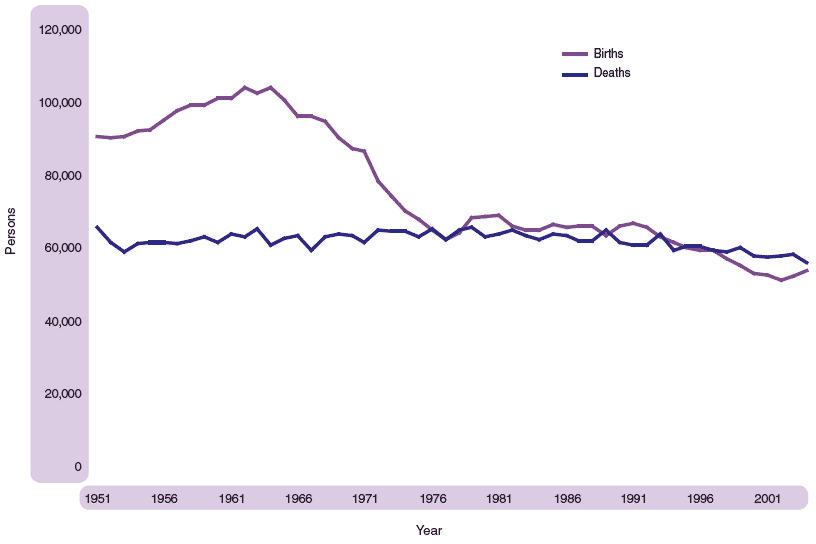
Fertility Rates
The simplest fertility rate is the so called crude birth rate the number of live births per 1,000 total population. Appendix 1 Table 1 shows that in 2004 the crude birth rate for Scotland stood at
10.6 compared with around 20 fifty years ago. Because it takes no account of the age/gender structure of the population, the crude birth rate has only limited value (e.g. for giving rough comparisons between areas with broadly similar age/gender structures). Appendix 1 Tables 2 and 3 present crude birth rates for administrative areas in Scotland and selected European countries. Appendix 1 Table 2 also gives standardised birth rates for the administrative areas of Scotland: these adjusted birth rates take account of the population structures in the different areas.
A better approach is to consider the general fertility rate (GFR) which is based on the numbers of women of childbearing age. Figure 1.11 shows the GFR (births per 1,000 females aged 15-44), along with the number of women aged 15-44. During the ‘baby boom’ of the 1960s the GFR reached 99.5 (in 1962). It then fell sharply to around 60 during the late 1970s and 1980s before declining more slowly during the 1990s; eventually dipping below 50 at the start of the 21st century. It has risen slightly over the last couple of years to its 2004 value of 51.0. Interestingly, the chart shows that the female population aged 15-44 was relatively low during the baby boom of the 1960s. Moreover, the levelling off in the annual numbers of births during the 1980s was in part associated with the increasing numbers of women born in the 1950s and 1960s passing through their childbearing years.
Figure 1.11 Estimated female population aged 15-44 and general fertility rate (GFR), Scotland, 1951-2004
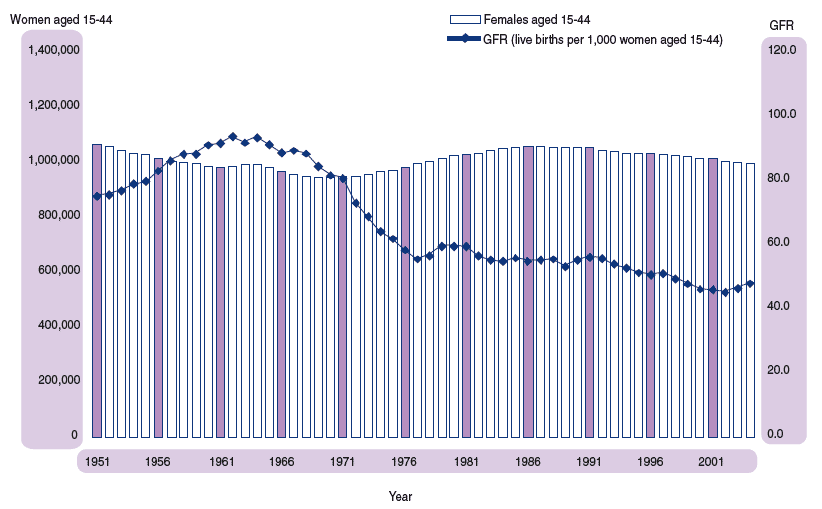
A more detailed picture is given by the age specific fertility rates (ASFRs) by mother’s age in five-year age groups in Figure 1.12. This chart shows many significant age-related features of the pattern of childbearing over the last fifty years. The key point is that, as well as choosing to have fewer babies, women are also choosing to have them later in life. Other points of interest are:
Figure 1.12 Live births per 1,000 women, by age of mother, 1951-2004
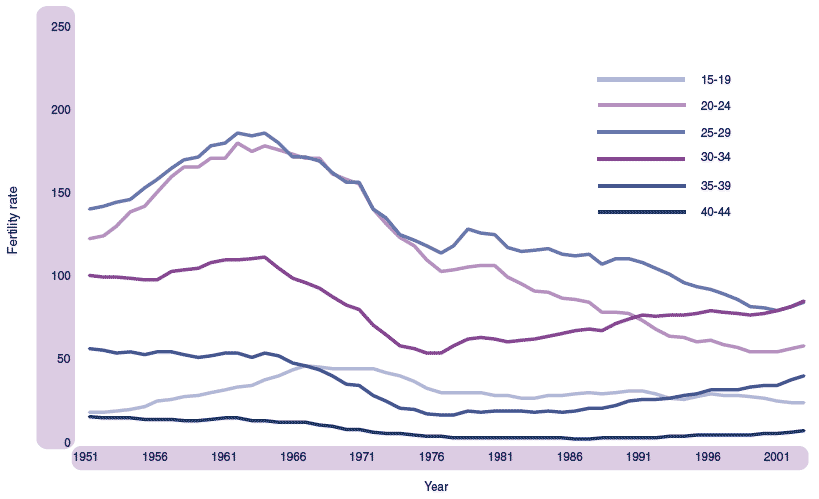
Figure 1.13 further illustrates the ageing pattern of fertility by showing detailed ASFRs for selected years: 1951, 1964, 1977, 1991 and 2004. Though the levels differed considerably, the age patterns of fertility for 1951, 1964 and 1977 were roughly the same. However, the age distribution for 1991 shows a distinctly older peak and that for 2004 reveals the large reduction in fertility of women in their twenties.
Figure 1.13 Live births per 1,000 women, by age, selected years
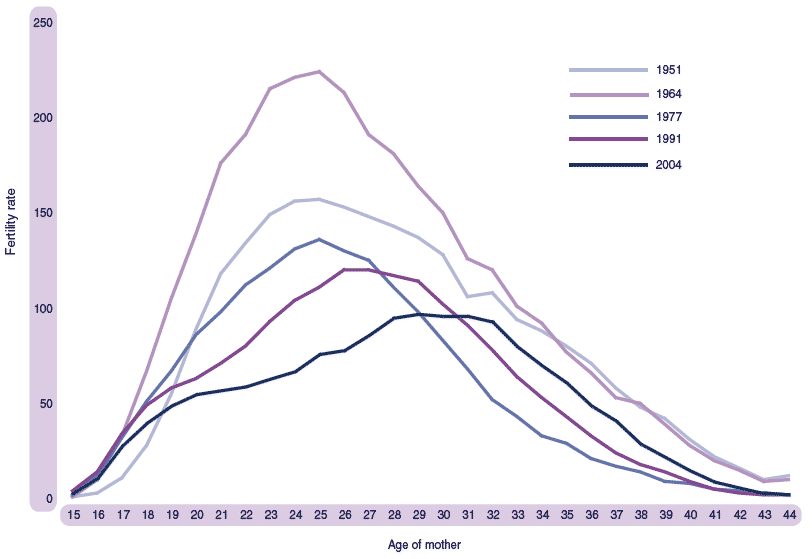
The trend towards later childbearing is underlined by an increase in the average age of all mothers to 29.4 in 2004, compared with 27.4 in 1991, 26.1 in 1977, and 27.4 in 1964.
The total fertility rate (TFR) is a commonly used summary measure of fertility levels calculated by summing the age specific rates for a single year. It gives the average number of children that a group of women would expect to have if they experienced the observed ASFRs in each of their childbearing years. For a population to replace itself, the TFR needs to be around 2.1.
The TFR for Scotland since 1951 is plotted in Figure 1.14. Not surprisingly, it follows the same general pattern as the GFR described above. It rose to 3.09 in 1964 before dropping sharply to 1.70 in 1977. Since then, with a few minor fluctuations, it fell more slowly to the 2002 rate of 1.48 before increasing to 1.54 in 2003 and 1.60 in 2004.
Figure 1.14 Total fertility rate, Scotland, 1951-2004
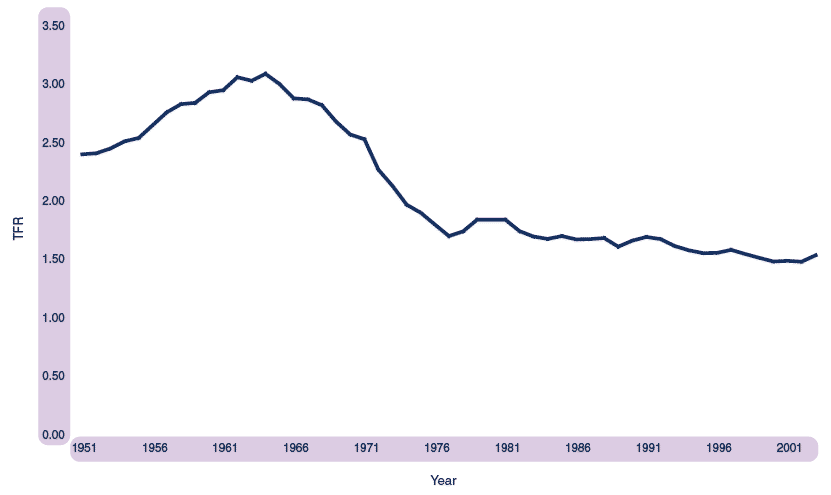
Though widely used, in part because it is relatively easy to calculate, the TFR has serious deficiencies as it is based on only one year’s observations. For example, when women are delaying childbearing, as they are in Scotland, the TFR is likely to underestimate the number of children women will eventually have.
A more satisfactory measure is average completed family size. Figure 1.15 shows the completed family size (or cumulative cohort fertility) by age for women born in selected years. Those born in 1951 had attained an average completed family size of 2.03 by the time they reached 45, whereas for those born in 1956 the figure was 1.93. The chart also permits the comparison of family size at selected ages for the various cohorts as they pass through the childbearing ages. For example, by age 30, the cumulative childbearing of the 1971 cohort is about 0.6 lower than that of the 1951 cohort. Of crucial importance is the extent to which the later cohorts are falling behind in family building. Whilst the increasing fertility rates of those aged over 30 may lead to some catching-up, it seems highly unlikely that this will increase the average completed family size to the levels attained as recently as the 1960s.
Figure 1.15 Cumulative cohort fertility rate for selected birth cohorts, Scotland
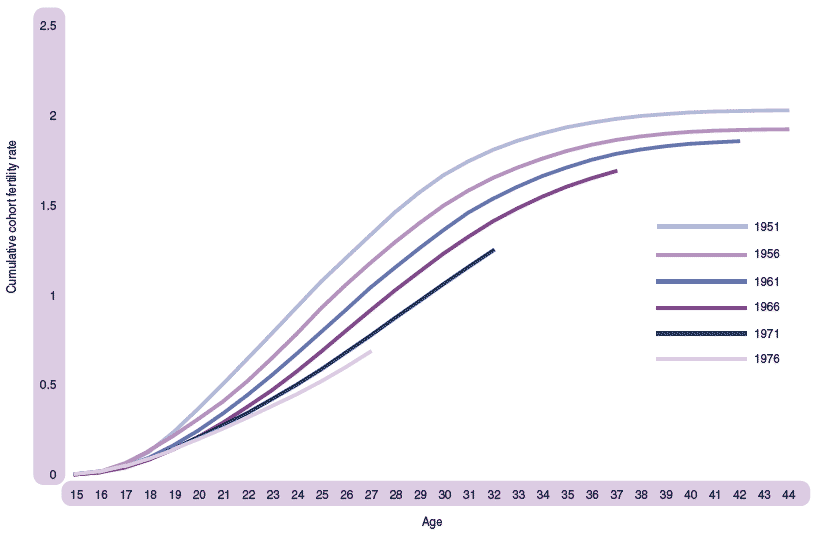
Scotland’s fertility has also been falling relative to other parts of the United Kingdom. Figure 1.16 compares the TFRs for England, Wales, and Northern Ireland with those for Scotland since 1971. Until the late 1970s, Scotland’s TFR was slightly higher than those for England and Wales. However, since the early 1980s, Scotland’s TFR has dropped steadily below the levels for England and Wales. In 1971 the TFR for Northern Ireland was markedly higher than for the other three countries. However, over the last 30 years this differential has been significantly reduced. It is interesting to note that the recent slight rise in fertility levels in Scotland has been paralleled elsewhere in the UK.
Figure 1.16 Total fertility rates, UK countries, 1971-2004
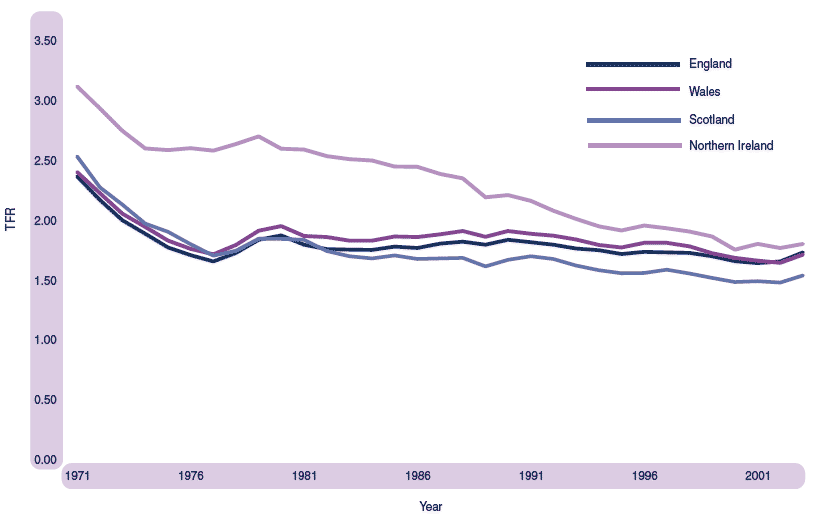
More detailed information on births and fertility was given in Chapters 2 and 3 of the 2002 report, Scotland’s Population 2002. Chapter 2 focused on recent trends in Scottish fertility, comparing these trends with the rest of the UK and Europe and Chapter 3 placed the Scottish fertility experience in a wider geographical context, discussing reasons for low fertility and addressing the scope for policy intervention.
Numbers
At 56,187, the number of deaths registered in Scotland in 2004 was 2,285 fewer than in 2003 and represented the lowest annual total recorded since the introduction of civil registration in 1855.
Figure 1.10 on page 13 shows that from 1951 up to the early 1990s the annual number of deaths remained relatively stable at about 60-65,000 a year. Since then the total has declined slowly to its current, historically low, level.
Stillbirths, perinatal deaths and infant deaths
As can be seen in Figure 1.17, there have been significant improvements in the rates for stillbirths, perinatal deaths and infant deaths in the period since 1971. The stillbirth rate has reduced from 13.1 per 1,000 total births (live and still) in 1971 to 5.8 in 2004, despite a change in the definition of stillbirths in 1992 which reduced the minimum period of gestation from 28 weeks to 24 weeks (thus increasing the numbers classified as stillbirths). The rate of perinatal deaths (stillbirths and deaths in the first week of life) fell from 24.5 per 1,000 total births in 1971 to 8.1 in 2004, an improvement of 67 per cent. Finally, the infant death rate (deaths of children aged under 1) has improved by 75 per cent from 19.9 per 1,000 live births in 1971 to 4.9 in 2004.
Figure 1.17 Stillbirth, perinatal and infant death rates, Scotland, 1971-2004
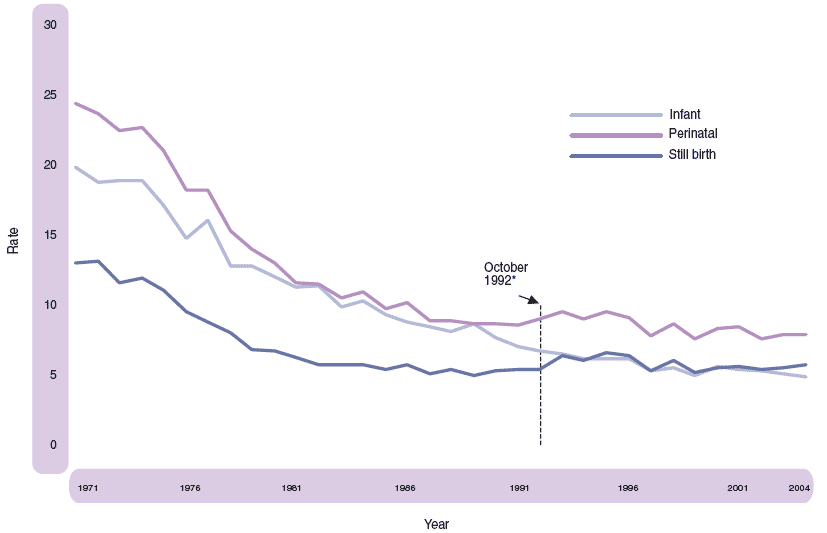
* Change in definition of stillbirths from 28 to 24 weeks’ gestation
Whilst the current rates are comparable to those for the UK as a whole, there are several western European countries that have significantly lower rates (see Appendix 1 Table 3).
Mortality by age
About 59 per cent of deaths were of people aged 75 and over, and a further 26 per cent were between the ages of 60 and 74.
The relative stability in the number of deaths over recent years masks significant improvements in age-specific mortality. Figure 1.18 shows, for both men and women, selected age-specific mortality rates over the last twenty years relative to the 1981 rates. The three age groups shown (45-64, 65-74 and 75 and over) account for around 95 per cent of all deaths.
At these ages, there have been greater improvements in male than in female mortality. For the 45-64 age group, males and females experienced improvements of 42 per cent and 39 per cent respectively. In the 65-74 age group, males showed an improvement of 40 per cent compared to 34 per cent for females. The greatest differential is in the 75 plus age group, where male mortality has improved by 24 per cent compared to only 9 per cent for females.
Figure 1.18 Age specific mortality rates as a proportion of 1981 rate, 1981-2004
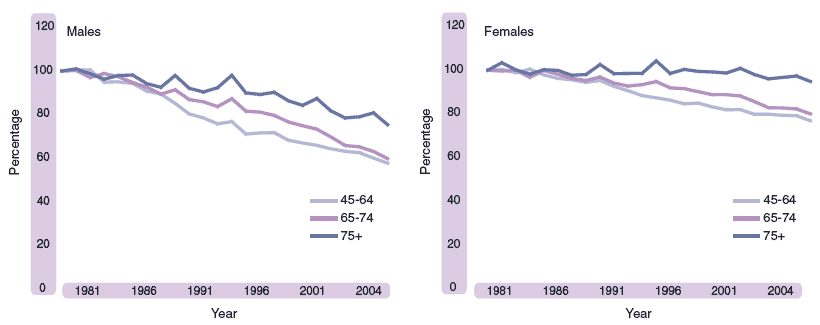
Life expectancy
Although mortality rates in Scotland have generally fallen more slowly than in the rest of the UK and elsewhere in Europe, the improvements are still considerable and the impact is demonstrated in the steadily rising expectation of life.
The expectation of life at birth is a commonly used summary measure of mortality rates which is particularly useful when comparing the ‘health’ of a nation through time and for making comparisons with other countries. Figure 1.19 shows that the expectation of life at birth in Scotland has improved greatly over the last 30 years or so, increasing from 67.3 years for males and 73.7 years for females born around 1971 to 74.2 years and 79.3 years respectively for those born around 2002. Figure 1.19 also illustrates that improvements in life expectancy at birth are projected to continue, rising to 78.9 for males and 83.6 for females by 2031.
Figure 1.19 Expectation of life at birth1, Scotland, 1971-2028
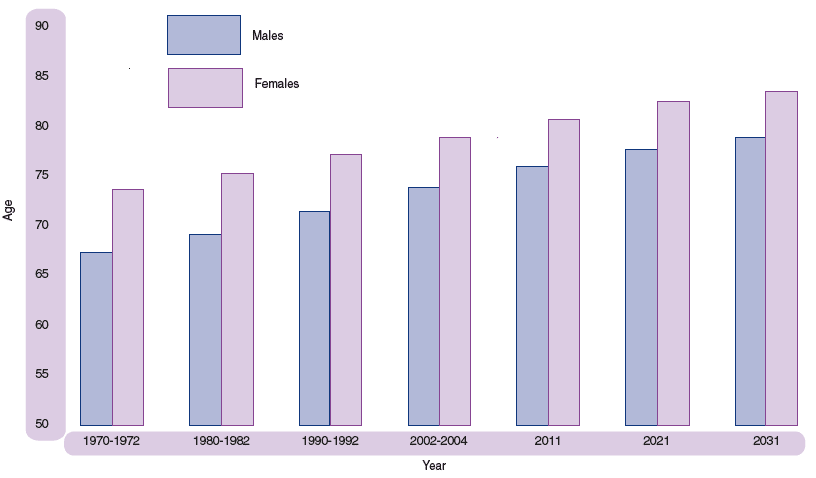
However, Scottish males and females have the lowest expectation of life at birth in the EU (15 states). For Scottish males, expectation of life is 1 year lower than the EU (25 states) average and, for females, it is 2 years lower. For both sexes, the expectation of life is more than 4 years lower than in the countries with the highest expectation of life.
Variations in mortality levels within Scotland
Standardised mortality ratios (SMRs), which compare local death rates with death rates in Scotland as a whole, taking account of the different population structure of each area, are presented in Figure 1.20. Five of the 32 Council areas have a standardised mortality ratio that is more than 10 per cent higher than the Scottish average of 100. All of these are in west central Scotland. The worst, Glasgow City, is 24 per cent higher than the Scottish average which itself is about 16 per cent higher than the UK average.
At the other end of the scale, 7 of the 32 Council areas have a standard mortality ratio that is more than 10 per cent lower than the Scottish average. The lowest was East Dunbartonshire which was 18 per cent below (or better than) the Scottish average. Aberdeenshire, East Renfrewshire and Shetland were respectively 14 per cent, 14 per cent and 13 per cent below the Scottish average.
Figure 1.20 Standardised mortality ratios, by Council area, 2004
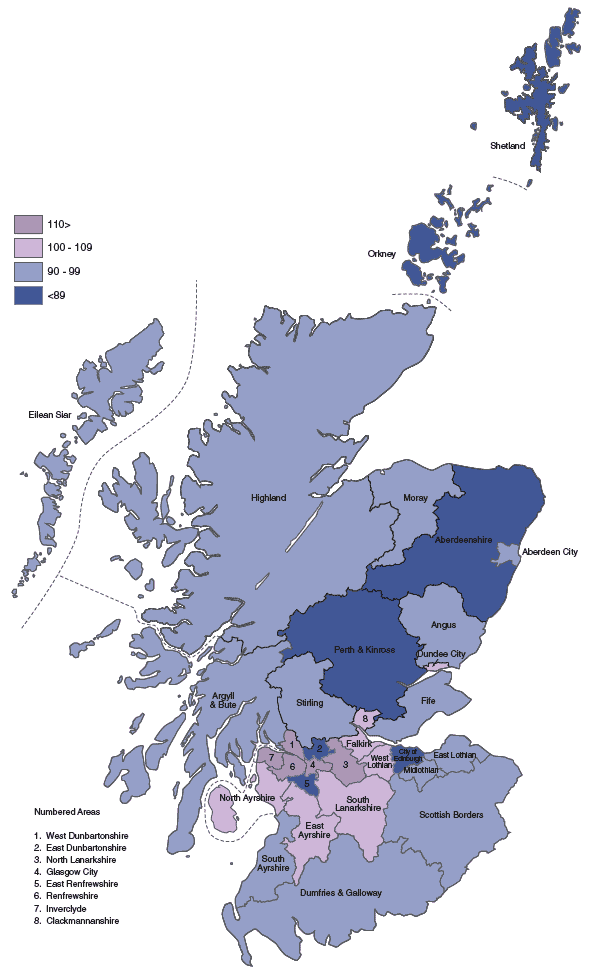
Cause of death
In 2004, the two most common causes of death in Scotland were cancer (15,047 deaths, 27 per cent) and ischaemic heart disease (10,778 deaths, 19 per cent). However, since 1981 the proportion of deaths caused by ischaemic heart disease has fallen from 29 to 19 per cent, whereas the proportion caused by cancer has risen from 22 to 27 per cent. And since 1995, there have been more deaths from cancer than ischaemic heart disease.
Cancer
Death rates, by sex, for the most common causes of death are shown in Table 1.1. Over the last 20 years or so, male death rates from lung cancer have fallen by over a quarter (from 119 per 100,000 population in 1980-82 to 88 in 2004). By contrast, the rates for women, though still considerably lower than those for men, have increased by over 60 per cent (from 41 per 100,000 population in 1980-82 compared to 67 in 2004).
Of the 15,047 deaths from cancers in 2004, trachea, bronchus and lung was the most common site, accounting for over a quarter (26 per cent) of all cancer deaths.
The next most frequent site for cancer deaths was prostate for men (802 deaths of which 63 per cent were aged 75 and over) and breast for women (1,082 deaths). Death rates for the former continue to increase whereas those for the latter have fallen in recent years.
Heart disease and stroke
In contrast to the rises for cancer, death rates for ischaemic heart disease and cerebrovascular disease (stroke) have shown significant declines. Since 1981, males have experienced slightly larger improvements (42 per cent for ischaemic heart disease and 32 per cent for stroke) compared with improvements of 38 and 30 per cent respectively for females.
Table 1.1 Death rates from selected causes, by sex, Scotland, 1980-2004
Males – rates per 100,000 population
Year |
Cancer |
Ischaemic heart |
Cerebrovascular |
||
|---|---|---|---|---|---|
All sites |
Trachea, bronchus |
Prostate |
|||
1980-82 |
291 |
119 |
19 |
408 |
139 |
1990-92 |
314 |
111 |
27 |
367 |
119 |
2000-02 |
321 |
93 |
32 |
261 |
101 |
2004 |
313 |
88 |
33 |
238 |
94 |
Females – rates per 100,000 population
Year |
Cancer |
Ischaemic heart |
Cerebrovascular |
||
|---|---|---|---|---|---|
All sites |
Trachea, bronchus |
Breast |
|||
1980-82 |
247 |
41 |
45 |
304 |
210 |
1990-92 |
278 |
57 |
48 |
297 |
191 |
2000-02 |
288 |
64 |
43 |
216 |
162 |
2004 |
280 |
67 |
41 |
189 |
147 |
Using the latest comparable data available, 2003, Figure 1.21 compares the death rates for the constituent countries of the UK for selected causes after adjusting for differences in age structure. The Scottish rates for cancer, ischaemic heart disease and cerebrovascular disease are well above the rates for the other countries of the United Kingdom for both men and women.
Figure 1.21 Age-adjusted mortality rates, by selected cause and sex, 2004
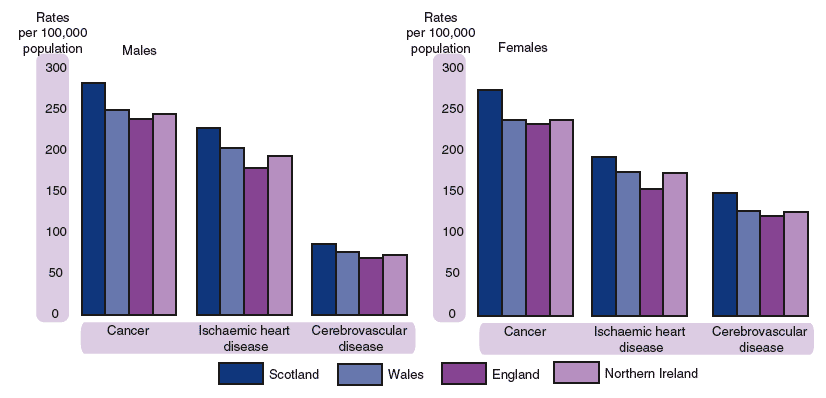
Source: ONS
Suicides
In 2004, deaths from intentional self-harm numbered 606 (448 males and 158 females), 46 more than in 2003. To allow for any under-recording of suicides, it is conventional to combine deaths classified as ‘events of undetermined intent’ with those for ‘intentional self-harm’, as most of the former are believed to be suicides. The total number of deaths classified to these two groups in 2004 was 835 compared with 794 in 2003 and 899 in 2002.
Suicide is the most common cause of death for men aged 15-34 and 35-44 and women aged 15-34. For men the most frequent cause of these deaths was hanging, strangulation and suffocation, whereas for women it was poisoning.
Main causes of death by age and sex
The main causes of death vary in frequency by age and sex (Figure 1.22). Accidents were the largest single cause amongst boys aged 1-14, accounting for almost a quarter of deaths. Cancer was the next largest cause. For girls aged 1-14, cancer was the most common cause with accidents and diseases of the nervous system ranking second equal.
For males aged 15-34, the main cause was suicide (intentional self-harm plus undetermined deaths) followed by accidents and mental disorders (almost entirely associated with drug and alcohol abuse). For females in this age group, suicide was also the largest category, but there were almost as many deaths from cancer.
Suicide was also the most frequent cause of death for males aged 35-44, cancer was second, closely followed by ischaemic heart disease. For women aged 35-44, cancer was the main cause followed by suicide.
For both sexes and all age groups between 45 and 74, cancer was the main cause followed by ischaemic heart disease. For women, cancer was responsible for a higher proportion of deaths in these age groups than for men. Conversely, ischaemic heart disease accounted for a higher proportion of deaths in these age groups for men than for women.
Figure 1.22 Deaths, by cause and age group, Scotland, 2004
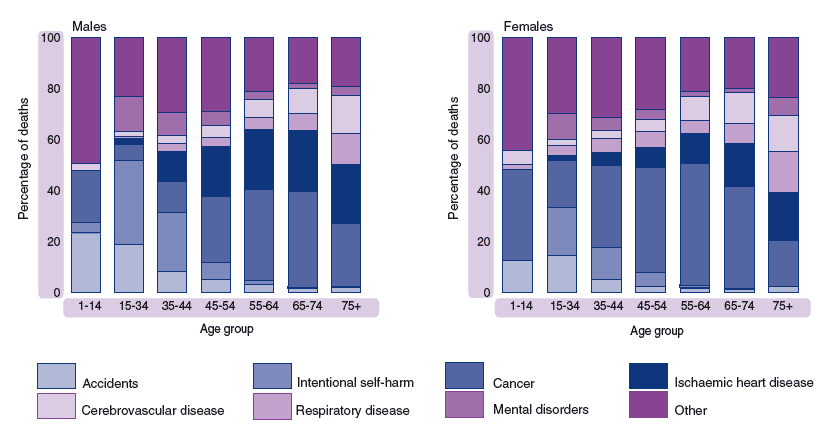
Besides births and deaths, migration is the other component of population change. However, unlike births and deaths, there is no comprehensive source for estimating migration and hence it is the most difficult component of change to measure and predict. The reasons for migrating are also much more affected by short-term changes in social and economic circumstances than births and deaths.
Recently, interest in migration has increased because in-migration can help counter the projected decline and the ageing of Scotland’s population. The Scottish Executive’s Fresh Talent Initiative aims to stem population decline, and alleviate possible labour force problems, by attracting young and economically active people to Scotland, and by encouraging others to stay.
The Registrar General’s Annual Report for 2003 includes a full analysis of migration data for Scotland. This included analysis of Census 2001 data on migrants and gave an overview of migration data used in the mid-year estimate for Scotland. A further analysis of Census 2001 data was published on 25 January 2005: /statistics/publications-and-data/occpapers/scotlands-census-2001-statistics-on-migration/index.html.
Trends in migration since 1951
Historically, Scotland has been a country of net out-migration, with more people leaving to live elsewhere than move to live in Scotland. However, since the 1960s net out-migration has reduced significantly and in recent years has been at less than half of the peak levels experienced in the 1960s. Indeed, in some years during the late 1980s and early 1990s, Scotland experienced net migration gain rather than loss and this has also been the case in the last two years with net gains of around 9,000 and 26,000, as can be seen from Figure 1.23.
Figure 1.23 Estimated net migration, Scotland, 1951-2004
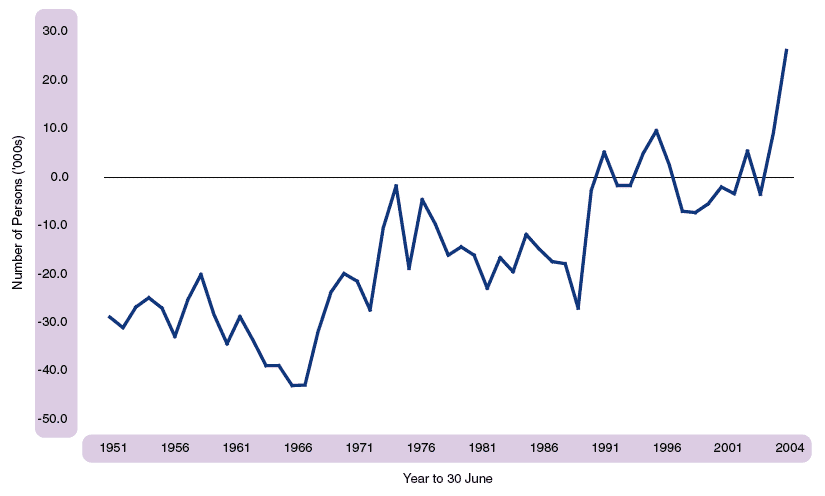
Net migration is the difference between much larger gross flows of migrants into and out of Scotland. In the last 10 years these have typically been of the order of about 70,000 in both directions. The balance can be affected by relatively small changes in these gross flows from year to year, particularly if one flow rises while the other falls. In the year to 30 June 2004, around 61,900 people came to Scotland from England, Wales and Northern Ireland and around 46,400 people migrated in the opposite direction giving a net migration gain from the rest of the UK of around 15,500. About 36,300 people (including asylum seekers) came from outside the UK and around 24,600 left Scotland in the opposite direction: a net migration gain of around 11,900.
Figure 1.24 illustrates the trend in flows of people to and from the rest of the UK since 1981. The UK flows have recently been fairly constant at about 50,000 in either direction, though out-migration has been reducing since 1999-2000.
Figure 1.24 Movements to/from the rest of the UK, 1981 to 2004
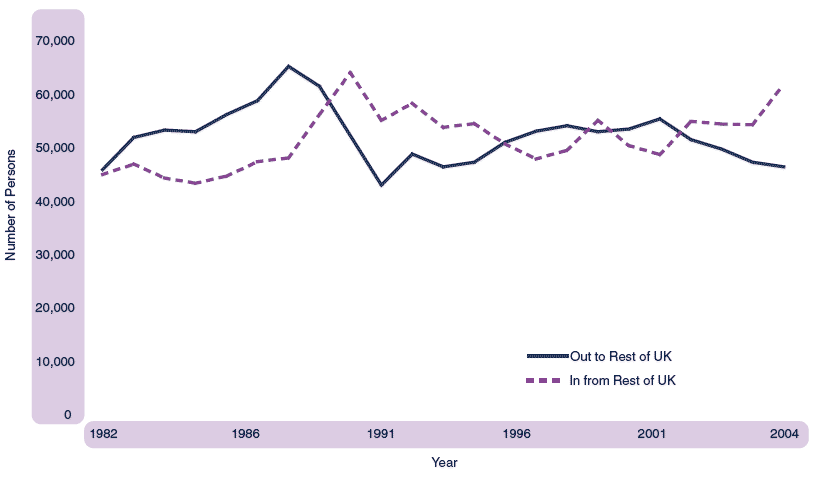
Source: National Health Service Central Register (NHSCR) patient movements.
Origins and destinations of UK migrants
Table 1.2 shows that in the year to mid-2004 around 20 per cent of people coming to Scotland from the rest of the UK went to the Lothian Health Board area, 12 per cent to Greater Glasgow and Grampian and 8 per cent to Tayside and Highland. Similarly, 22 per cent of people leaving Scotland to go to the rest of the UK were from Lothian, 17 per cent from Greater Glasgow and 12 per cent from Grampian. The Health Board areas with the highest net gain were Highland, Grampian and Lothian all with net inflows of over 2,000.
Table 1.2 Movements between Scotland and the rest of the UK by Health Board area, mid 2003 to mid 2004
Rest of UK |
% of |
Rest of UK |
% of |
Net |
|
|---|---|---|---|---|---|
Argyll and Clyde |
3,775 |
6 |
3,267 |
7 |
508 |
Ayrshire and Arran |
3,244 |
5 |
2,564 |
6 |
680 |
Borders |
2,441 |
4 |
1,382 |
3 |
1,059 |
Dumfries and Galloway |
3,252 |
5 |
1,758 |
4 |
1,494 |
Fife |
3,972 |
6 |
3,013 |
6 |
959 |
Forth Valley |
2,991 |
5 |
2,014 |
4 |
977 |
Grampian |
7,678 |
12 |
5,334 |
12 |
2,344 |
Greater Glasgow |
7,600 |
12 |
7,891 |
17 |
-291 |
Highland |
4,761 |
8 |
1,940 |
4 |
2,821 |
Lanarkshire |
3,549 |
6 |
2,875 |
6 |
674 |
Lothian |
12,283 |
20 |
10,132 |
22 |
2,151 |
Orkney Islands |
474 |
1 |
150 |
0 |
324 |
Shetland Islands |
389 |
1 |
212 |
0 |
177 |
Tayside |
4,930 |
8 |
3,608 |
8 |
1,322 |
Western Isles |
540 |
1 |
217 |
0 |
323 |
Scotland Total |
61,879 |
100 |
46,357 |
100 |
15,522 |
Source: National Health Service Central Register (NHSCR) patient movements.
People coming to Scotland from the rest of the UK came mainly from England (96 per cent): 16 per cent from the North West, 15 per cent from London, 15 per cent from the South East, 10 per cent from Yorkshire and the Humber, 9 per cent from the South West, 9 per cent from the North East, 8 per cent from the East, 7 per cent from the East Midlands and 6 per cent from the West Midlands. There were fairly similar proportions of people going to these areas of England from Scotland. For example, about 17 per cent went to the South East, 14 per cent to the North West and 14 per cent to London.
The age and sex of migrants
The age and sex of migrants remains relatively constant from year to year. Figure 1.25 illustrates this for males and females moving into and out of Scotland from the rest of the UK in the year to 30 June 2004. The peak ages for migrating are the late teens to mid-20s, reflecting moves out of the parental home to attend higher education or take up employment. There also tend to be smaller peaks for moves of the very young, reflecting migration of parents who move home before their children have started school. The pattern of migration is very similar for men and women though women appear to migrate more than men in their early 20s (though this may result from different patterns of re-registering with an NHS doctor after a move – the main data source for migration estimates – rather than different patterns of migration).
Figure 1.25 Movements between Scotland and the rest of the UK, by age, mid 2003 to mid 2004
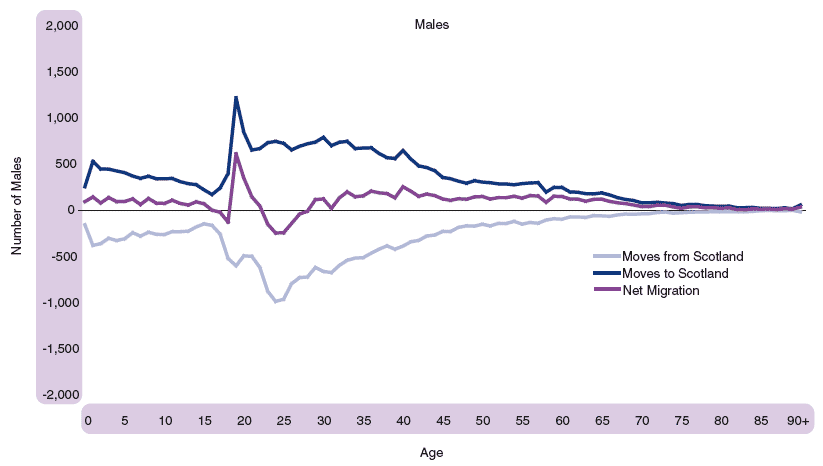
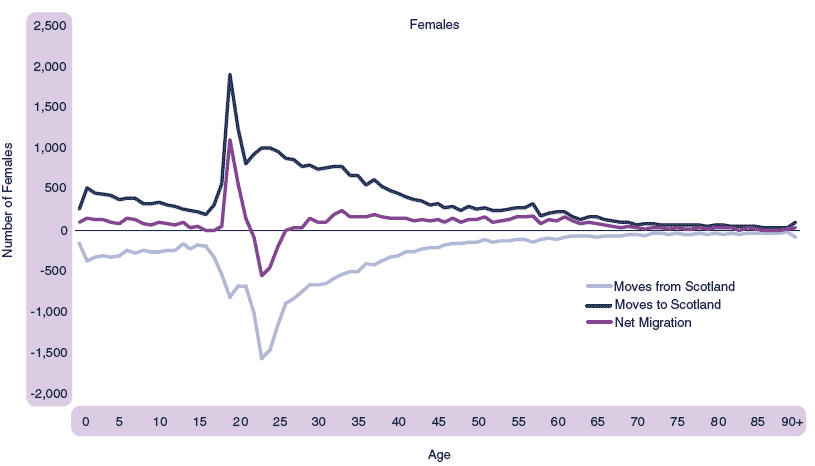
Source: National Health Service Central Register (NHSCR) patient movements
The peaks in migration for males and females in their late teens and early 20s create marked net migration gains at ages 19 and 20, and net migration losses at ages 23 and 24. These patterns are consistent with an influx of students from the rest of the UK and overseas starting higher education, followed by a further move after graduation. Later in life, there is no significant "retirement migration" in either direction.
Migration trends
Figure 1.26 shows that in the year to mid 2004, Scotland gained people of all age groups from the rest of the UK. The figures for earlier years show that movement of all groups into Scotland is tending to increase.
Figure 1.26 Net movements between Scotland and the rest of the UK by age, 2001-2004
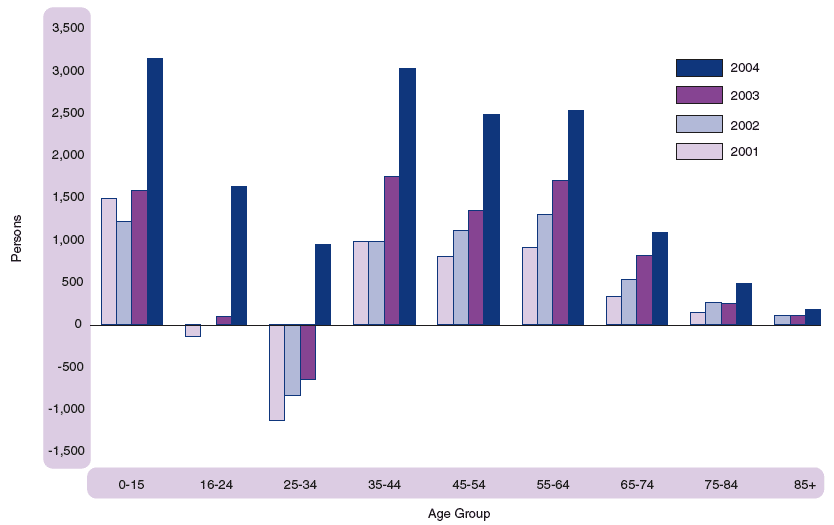
Source: National Health Service Central Register (NHSCR) patient movements
Table 1.3 shows net movements as well as movements to/from the UK and overseas between mid-2003 and mid-2004 by age group. The source for the overseas migration is the International Passenger Survey and, as the sample size in Scotland is small, information about GP registrations is used to attribute an age distribution. A couple of interesting points are:
As previously noted, migrants tend to be much younger than the general population with 45 per cent of in-migrants aged 16-34 compared with 24 per cent of the resident population;
Only 3,506 (6 per cent) of people coming to Scotland from the rest of the UK were aged 65 and over, as were an assumed 6 per cent of overseas migrants.
Table 1.3 Rest of UK/Overseas moves by age group
Numbers |
||||||||||
|---|---|---|---|---|---|---|---|---|---|---|
Movements between Scotland and the rest of the UK1 |
||||||||||
0-15 |
16-24 |
25-34 |
35-44 |
45-54 |
55-64 |
65-74 |
75-84 |
85+ |
All ages |
|
IN |
10,621 |
13,034 |
14,597 |
9,943 |
5,691 |
4,487 |
2,044 |
1,046 |
416 |
61,879 |
OUT |
7,473 |
11,400 |
13,646 |
6,920 |
3,206 |
1,957 |
955 |
559 |
241 |
46,357 |
NET |
3,148 |
1,634 |
951 |
3,023 |
2,485 |
2,530 |
1,089 |
487 |
175 |
15,522 |
Movements between Scotland and Overseas (including asylum seekers excluding unmeasured migration adjustment)2 |
||||||||||
IN |
5,832 |
9,475 |
8,885 |
5,367 |
2,846 |
2,042 |
982 |
577 |
294 |
36,300 |
OUT |
4,025 |
6,700 |
6,274 |
3,504 |
1,772 |
1,160 |
581 |
377 |
207 |
24,600 |
NET |
1,807 |
2,775 |
2,611 |
1,863 |
1,074 |
882 |
401 |
200 |
87 |
11,700 |
Total net migration (including asylum seekers, rounding and unmeasured migration adjustments)3 |
||||||||||
NET |
4,613 |
3,784 |
3,388 |
4,981 |
3,552 |
3,382 |
1,434 |
633 |
237 |
26,004 |
Percentages |
||||||||||
Movements between Scotland and the rest of the UK1 |
||||||||||
IN |
17 |
21 |
24 |
16 |
9 |
7 |
3 |
2 |
1 |
100 |
OUT |
16 |
25 |
29 |
15 |
7 |
4 |
2 |
1 |
1 |
100 |
Movements between Scotland and Overseas (including asylum seekers excluding unmeasured migration adjustment)2 |
||||||||||
IN |
16 |
26 |
24 |
15 |
8 |
6 |
3 |
2 |
1 |
100 |
OUT |
16 |
27 |
26 |
14 |
7 |
5 |
2 |
2 |
1 |
100 |
1 National Health Service Central Register (NHSCR) patient movements mid-2003 to mid-2004.
2 Totals are based primarily on International Passenger Survey (IPS) data. However, the sample size in Scotland is too small to give an age breakdown so an age distribution is assumed using NHSCR data.
3 Note that the movements between Scotland and the rest of the UK and overseas will not sum to the total net migration as they exclude unmeasured migration and rounding adjustments.
Migration and the distribution of Scotland’s population
In many parts of Scotland, migration is the most important component of population change. Net migration rates (here, the amount of net migration between 1994 and 2004 as a proportion of the 1994 population) are a useful indicator when comparing migration between areas of different sizes. Information on net rates for Council areas is shown in Figure 1.27.
Figure 1.27 Net migration rates for Council areas, 1994 to 2004
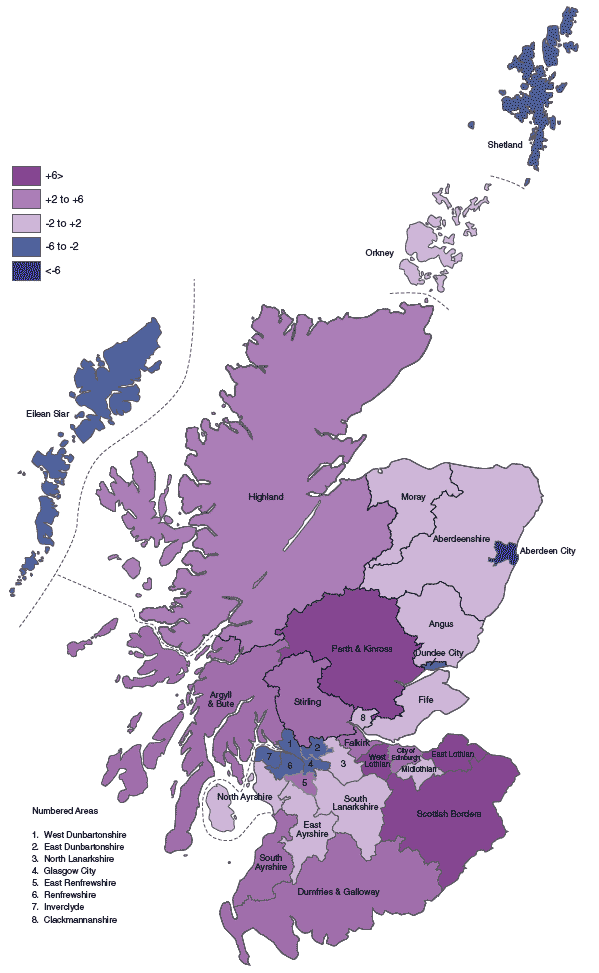
The highest net out-migration rates were in Aberdeen City, the Shetland Islands and Inverclyde, while the highest net in-migration rates were in East Lothian, West Lothian and Perth & Kinross.
Numbers
There were 32,154 marriages in Scotland in 2004, 1,397 (4.5 per cent) more than in 2003 and the highest total since 1993. Figure 1.28 shows that, following a decline from over 40,000 marriages a year in the early 1970s, the annual total has levelled out at around 30,000. However, recent years have seen an increasing number of marriages where neither the bride nor groom was resident in Scotland. There were some 9,710 marriages in this category in 2004 (compared with 8,917 in 2003), nearly half of which were at Gretna. More information on marriages at Gretna is given in Chapter 2 of this report (page 72). The information in this section covers all marriages registered in Scotland, regardless of the usual residence of the parties involved. Of course, many couples who are resident in Scotland go abroad to be married. These marriages are not included in this chapter, and only some come to the attention of the Registrar General through notification to British consular authorities.
Figure 1.28 Marriages, Scotland, 1971-2004
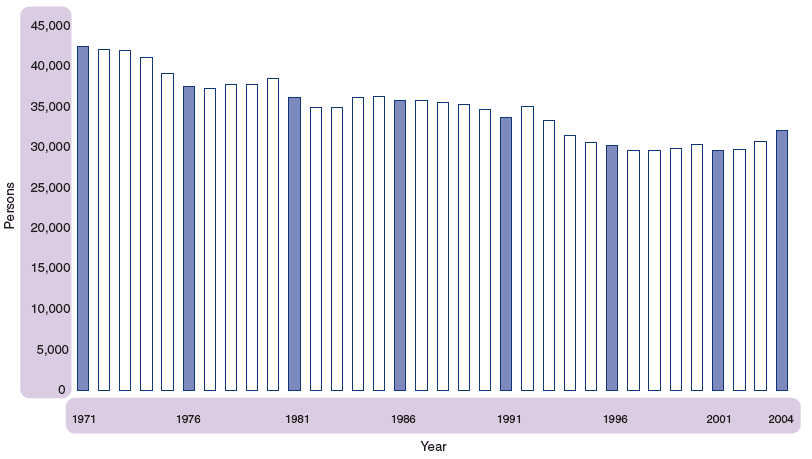
Marital status at marriage
Figure 1.29 shows the percentage of marriages by marital status at the time of marriage between 1971 and 2004. The percentage of people marrying who had been divorced was just under 6 per cent during 1971, but by 2004 over a quarter (28 per cent for males and 27 per cent for females) of those marrying were divorced. The majority of this shift reflects a reduction in the proportion of marriages where one of the partners was a bachelor/spinster. However, the proportion of those marrying who were widowed has also declined slightly – in 2004 the proportion was about 2 per cent whereas it was just over 3 per cent in 1971.
Figure 1.29 Marriages, by marital status of persons marrying, 1971 to 2004
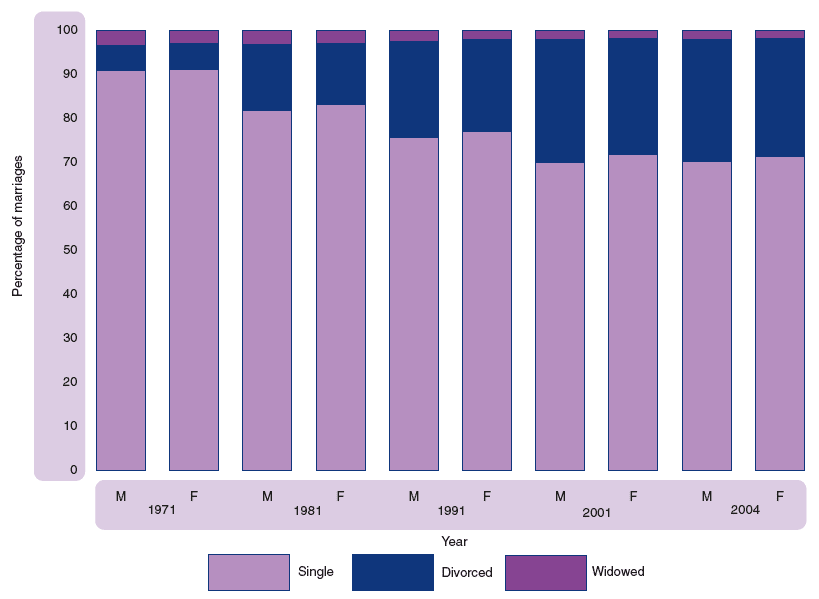
Marriages by type of ceremony
Civil marriages accounted for almost half (49 per cent) of all marriages in 2004 compared to around one-third in 1971 (Figure 1.30). The trend mainly reflects a decline in the number of religious ceremonies during the 1970s, 1980s and early 1990s. The small increase in religious marriages observed during the period 1997-2002 was largely associated with the increase of ‘tourism’ marriages, of which a significant proportion were carried out at Gretna.
Figure 1.30 Marriages by type of ceremony, Scotland, 1971-2004
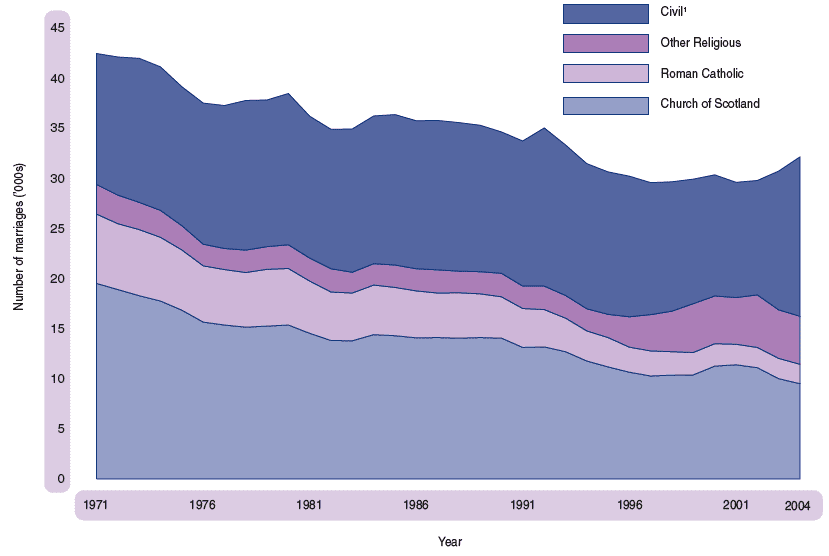
1 Includes irregular Marriages
Until 2002, civil marriages could only be held in registration offices. The Marriage (Scotland) Act 2002 allowed registrars to conduct ceremonies in other "approved places", from June 2002. Over 600 venues have now been approved, including castles, hotels, clubs and a small number of outdoor venues in gardens or the countryside.
During 2003, the first full year of the new arrangements, 3,465 civil ceremonies (11 per cent of all marriages and 25 per cent of civil marriages) were held in "approved places". In 2004, the total had risen to 5,974 (19 per cent of all marriages and 38 per cent of civil marriages). There was a corresponding decrease in the number of religious marriages, from 18,371 in 2002, to 16,890 in 2003 and 16,242 in 2004.
Just over half of the 16,241 religious marriages were celebrated in places of worship and most civil marriages in registration offices (9,937 or 62 per cent). Hotels were the venue for about 2,800 religious and 2,500 civil ceremonies, while approximately 1,000 religious and 500 civil marriages took place in castles and other historic buildings and 50 religious and 25 civil marriages were held on ships and barges. A fuller list of venues, and a geographical breakdown, is available on the website at www.nrscotland.gov.uk
Numbers
The number of divorces in 2004 was 11,227, some 299 more than in 2003. Figure 1.31 shows the number of divorces between 1971 and 2004. There was a marked increase in the number of divorces up to a peak of 13,373 in 1985. Recent years have seen a slight fall from the levels recorded in the late 1980s and 1990s. It is probable that increasing levels of co-habitation may be relevant to the recent decline in divorces, since divorce proceedings are not necessary to sever such relationships.
The information in this report relates to divorces granted under the Divorce (Scotland) Act 1976 and earlier legislation, and covers divorces granted in Scotland, regardless of where the marriage took place.
Figure 1.31 Divorces, Scotland, 1971-2004
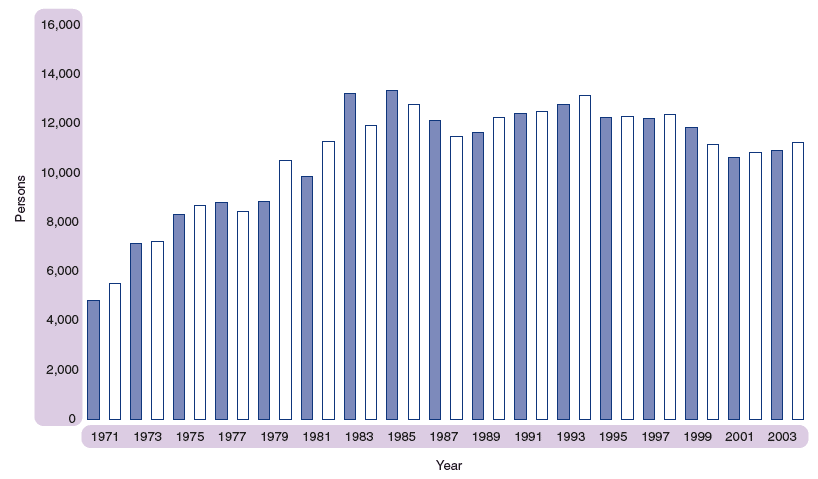
Figure 2.23 shows the trend in grounds for divorce between 1981 and 2004. The Divorce (Scotland) Act 1976 introduced new grounds for divorce – principally non-cohabitation, meaning that couples separated for two years (with mutual consent) or five years (without consent) could file for divorce on grounds of non-cohabitation.
In 2004, non-cohabitation was the most frequent reason for divorce, accounting for 82 per cent of all divorces. Non-cohabitation (2 years and consent) increased from 25 per cent of all divorces in 1981 to 54 per cent of all divorces in 2004; non-cohabitation (5 years) increased from 14 per cent to 28 per cent; and adultery as the stated reason for divorce fell from 17 per cent to 4 per cent.
Of those divorcing in 2004, 16 per cent of both men and women had divorced previously. This compares with 8 per cent for males and 7 per cent for females in 1981. This is consistent with the increase in the proportion of all marriages where one or both participants was divorced previously (now 2 in 5 marriages compared with 1 in 4 twenty years ago).
In 2004, the median duration of marriage ending in divorce was 14 years, whereas the comparable duration for 1981 was 9 years. In part, this increase will reflect the changing balance between cohabiting relationships and marriage.
In 2004, 27 per cent of all divorces involved couples where at least one of the partners had been aged 20 or under when they married. This is a significant fall from 60 per cent in 1981, but not unexpected given that the proportion of marriages where at least one of the partners was aged 20 or under has fallen from 36 per cent in 1981 to 3 per cent in 2004.
The Registrar General recorded 393 adoptions during 2004 – 75 fewer than in 2003, but slightly more than in 2002. This latest total represents around half the number recorded in the early 1990s and a quarter of the number recorded in the 1970s.
Some 33 per cent of the children adopted in 2004 were adopted by a step-parent and 61 per cent were adopted by non-relatives of the child. Only 18 per cent of children adopted in 2004 were aged under two, nearly all being adopted by non-relatives. By contrast, only 14 per cent of the 85 adoptions of children aged over ten were by non-relatives.